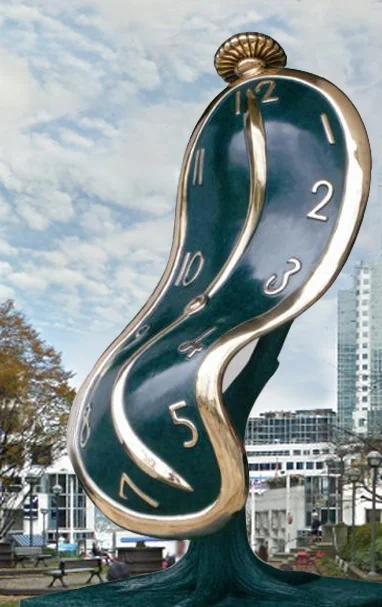
On May 6, the Chali-Rosso Art Gallery commemorated Canada’s 150th anniversary with the unveiling of Salvador Dali’s 1979 work, Dance of Time I, a seven-foot tall and 860 lb bronze sculpture of a dancing clock that is valued at $750,000.
Courtesy of The Stratton Institute, the Dalinian piece will be on display in the Heritage District at Hornby and West Hastings from May to September 2017.
This sculpture is part of the gallery’s Definitely Dali exhibit and will be on display for 150 days with the additional twenty gallery-size Dali sculptures in their Howe Street location. Gallery sales will go to Arts Umbrella, a non-profit organization for youth education in the arts.
Like many of Dali’s recurring clock motifs, the visiting sculpture delivers a message relevant to the societal confrontation of time as a fabricated illusion that contributes to the maintenance and distribution of order in an undisciplined universe.
“Nowadays we’re always running out of time, Dali reminds us that time doesn’t really exist. The sculpture [Dance of Time I] is a perfect tool in which he creates the arc from surrealism to reality,” said Oree Gianacopoulous, the gallery's director.
As seen in the fantastical orientation of his sculpture, Dali demonstrates the perception of time as influenced by different circumstances, making time a personalized entity rather than one universal experience.
The melted clock moves to the beat of the universe, disregarding any boundaries or man made events that may inhibit its movement. The perpetual rhythm of time does not sync with the structures of humanity because of its constant motion, reminding us that time is a human attempt for order and structure in a chaotic world and even in moments of peril, time is ultimately dancing to a rhythm outside of human reach.
“It confronts us with our own questions with time. Perhaps how we’re living. The piece is meant to emphasize fluidity,” said Susanna Strem, owner and curator.
The clock emblem shows us that the rigid principles of time may just be as soft as a dance. The juxtaposition of the sculpture’s two themes, order and fluidity, complement each other in conveying a strong message about the inherent human-inducing dependence on supervision, while portraying the fluid perception of time as flexibly liberal to the uniqueness of individual perspectives.
The unveiling and the exhibition focused primarily on the quirkiness and weirdness of Salvador Dali’s art but lacked deeper insight on the artist himself. Representation of Dali’s diverse interests – from quantum mechanics to politics – wasn't as incorporated in the exhibition as it should’ve been, given its subject. In addition to the display of Dali’s artwork, the exhibition itself lacked the fantastical and bizarre Dalinian touch seen in his art.
The unveiling was a treat for both the casual art appreciator and the learned art historian. The event was filled with insightful thoughts, strange optical illusions and a surprising visit from a local cannabis rally, selling hair-raisingly cheap edible concoctions made to enjoy at one’s discretion. Overall, excitement and support from the array of attendants is a testament to the committee’s hard work and dedication to bringing this iconic sculpture to Vancouver.

